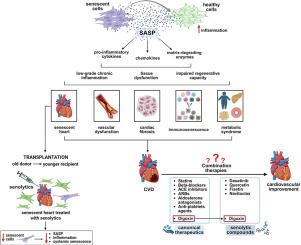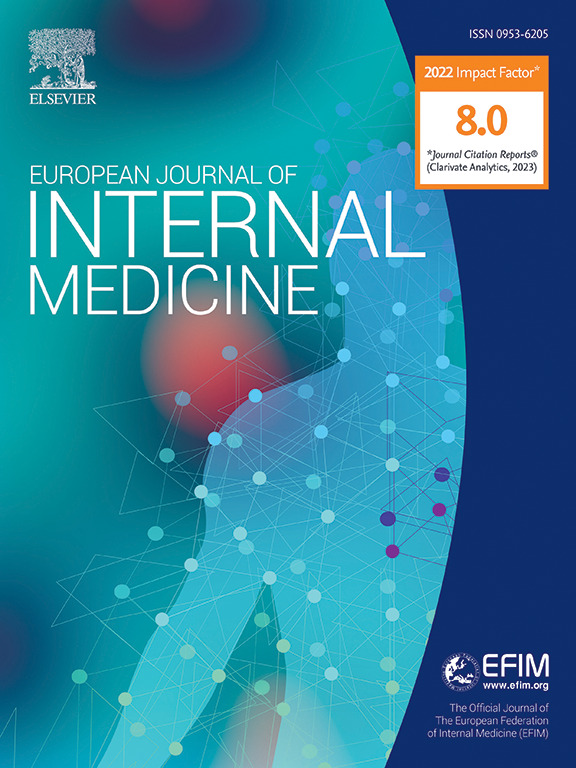心血管衰老的抗衰老疗法:治疗纤维化和代谢功能障碍。
IF 6.1
2区 医学
Q1 MEDICINE, GENERAL & INTERNAL
引用次数: 0
摘要
心血管疾病(CVD)仍然是发病率和死亡率的主要原因,衰老是一个关键的危险因素。细胞衰老,以不可逆的细胞周期阻滞和促炎分泌表型为标志,驱动与年龄相关的心血管疾病,包括血管功能障碍、动脉粥样硬化、心脏纤维化和代谢紊乱。抗衰老药物是一种有选择性地消除衰老细胞的药物,是一种很有前途的治疗策略。这篇综述探讨了衰老在CVD中的作用,并评估了衰老治疗在改善血管功能、减少纤维化以及解决CVD相关代谢和免疫功能障碍方面的潜力。临床前研究显示在改善心脏功能方面有希望的结果,特别是在治疗心力衰竭、心肌梗死后恢复和心脏移植方面。CVD中衰老和免疫衰老之间的相互作用也被研究,强调了抗衰老药物恢复免疫反应和减轻慢性炎症的潜力。此外,本文还讨论了抗衰老药物通过减轻全身炎症和胰岛素抵抗来解决代谢综合征(CVD的一个重要因素)的作用。虽然临床数据仍然有限,但早期试验和强有力的临床前证据为进一步研究心血管疾病中的老年痴呆提供了令人信服的理由。鉴于此,本综述最后强调了临床前和临床研究的挑战和需要,以确定抗衰老药物的有效性、安全性、剂量和长期影响,并将其作为心血管医学的一种变革方法。本文章由计算机程序翻译,如有差异,请以英文原文为准。

Senolytic therapies for cardiovascular aging: tackling fibrosis and metabolic dysfunction
Cardiovascular disease (CVD) remains a leading cause of morbidity and mortality, with aging as a critical risk factor. Cellular senescence, marked by irreversible cell cycle arrest and a pro-inflammatory secretory phenotype, drives age-related cardiovascular pathologies, including vascular dysfunction, atherosclerosis, cardiac fibrosis, and metabolic disturbances. Senolytics—agents that selectively eliminate senescent cells—represent a promising therapeutic strategy. This review explores the role of senescence in CVD and evaluates senolytics potential to improve vascular function, reduce fibrosis, and address CVD-related metabolic and immune dysfunctions. Preclinical studies have shown promising results in improving heart function, particularly in the treatment of heart failure, in post-myocardial infarction recovery, and cardiac transplantation. The interplay between senescence and immunosenescence in CVD is also examined, highlighting the potential of senolytics to rejuvenate immune responses and attenuate chronic inflammation. Furthermore, the review discusses the role of senolytics in addressing metabolic syndrome, a significant contributor to CVD, by alleviating systemic inflammation and insulin resistance.
While clinical data remain limited, early-phase trials and strong preclinical evidence provide a compelling rationale for further investigating senolytics in cardiovascular contexts. In this light, the review concludes by emphasizing the challenges and the need for extended preclinical and clinical studies to establish the efficacy, safety, dose, and long-term effects of senolytics and to exploit them as a transformative approach in cardiovascular medicine.
求助全文
通过发布文献求助,成功后即可免费获取论文全文。
去求助
来源期刊
CiteScore
9.60
自引率
6.20%
发文量
364
审稿时长
20 days
期刊介绍:
The European Journal of Internal Medicine serves as the official journal of the European Federation of Internal Medicine and is the primary scientific reference for European academic and non-academic internists. It is dedicated to advancing science and practice in internal medicine across Europe. The journal publishes original articles, editorials, reviews, internal medicine flashcards, and other relevant information in the field. Both translational medicine and clinical studies are emphasized. EJIM aspires to be a leading platform for excellent clinical studies, with a focus on enhancing the quality of healthcare in European hospitals.

 求助内容:
求助内容: 应助结果提醒方式:
应助结果提醒方式:


